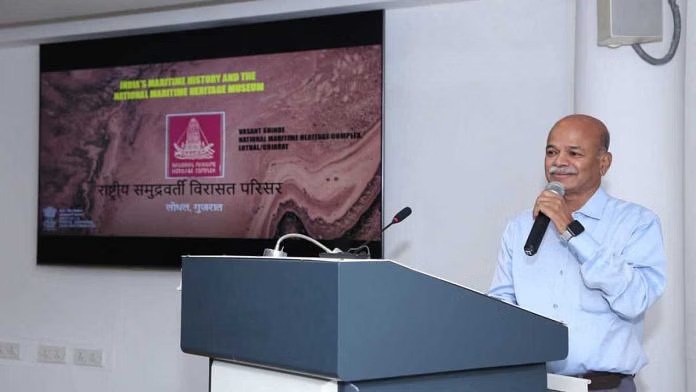
Harappans were hungry for growth. It pushed them to build maritime contacts
NEW DELHI : It was the urge to grow faster that pushed Harappans to establish maritime contacts with other parts of the world. They had the technology and were eager to develop their culture. “At one stage they realised that the revenue they generate is not really good enough to go to the next level. That is how they began to develop maritime contacts, and they first started with Oman,” said Vasant Shinde, Renowned Archaeologist and Former Director-General of National Maritime Heritage Complex (NMHC), Lothal. He was speaking at a lecture titled ‘Indian Maritime History and the Development of the National Maritime Museum at Lothal’, held at the Indian National Trust for Art and Cultural Heritage (INTACH) here.
The lecture was part of INTACH’s ‘Maritime Heritage of India’ series, and the audience included archaeologists and maritime experts such as Rajiv Nigam. Shinde’s hour-long lecture provided a comprehensive and scholarly overview of India’s enduring maritime legacy and the strategic significance of NMHC Lothal. Two key factors drove the Harappans to build trade contacts.
The first, according to Shinde, was the absence of critical resources in the Harappan region. The second was that “they were innovative people who wanted to develop their culture,” he said. So, they focused on establishing relationships with communities in the hinterland to procure raw materials, such as beads for bead making.
It is this enthusiasm for growth and maritime exploration that NMHC Lothal seeks to capture. In 2019, the Union Cabinet, chaired by Prime Minister Shri Narendra Modi, approved the development of a maritime heritage complex at Lothal. The aim was to celebrate and showcase India’s extensive maritime history, which spans over 4,500 years. Work on six museum galleries is expected to be completed by September this year, as part of the development of Phase-1A of the project. The complex, in its entirety, will be completed in two phases.
“Earlier, we didn’t have a museum that could showcase our entire maritime heritage,” said Shinde, adding that recent government estimates place India’s maritime area at around 11,000 kilometres.
Lothal Maritime Complex
Archaeological evidence suggests that Lothal is the earliest dockyard in the world. And this rich maritime history will be showcased in the upcoming National Maritime Heritage Complex at Lothal, a site that the Archaeological Survey of India excavated multiple times between 1955 and 1960, under veteran archaeologist Shikaripura Ranganatha Rao.
Shinde, who has played a crucial role in drafting the blueprint of NHMC Lothal, said that its 14 galleries will draw on archaeological evidence from ancient maritime centres across different eras – Harappan to medieval. A decommissioned Indian Navy warship and a naval transport plane will also be showcased at the complex. Shinde described all the galleries in detail during the lecture. Some of them were: Harappans – The Pioneer Seafarers, Post Harappan Trajectories, Contact with Greek-Roman World, Evolution of Indian Navy and Coast Guard, Trade and Cultural Relations with Southeast Asia and Beyond, Maritime Traditions of Gujarat.
Modi’s hometown Vadnagar will also be a part of the heritage complex, he said.
“The tangible and intangible maritime heritages of Gujarat will form a part of the galleries. The role played by some important ports – such as Lothal, Bharuch, and Kamroj – in trade and commerce will also be emphasised. The museum complex will also showcase the ancient Vallabhipur University, and Vadnagar’s [historical linkages] with the outside world,” said Shinde.
‘Founders of Indian culture’
The Harrapans, who lived for about 2,000 years, knew how to survive and save their culture. Realising the challenges of sustenance in the backdrop of harsh climatic conditions, they moved away from the Indus and Saraswati region basins to the Ganga-Yamuna-Doab areas. According to Shinde, this movement was not sudden. “We call that as a slow decline of the Harappan culture, where people started moving in different directions,” said Shinde. Several early farming communities already existed outside the Harappan region. The Harappans went there and got mixed up with them, he added.
According to Shinde, Harappans “are the founders of Indian culture”. “Most of the traditions and the knowledge systems that you know about were developed by the Harappans. That has continued till today without any break,” he said.
The Harappans had different philosophies, different administrative systems, and definitely had a democratic setup, Shinde added. Mesopotamians had a monarchical system, which is why development couldn’t go beyond royal families.
“The Harappans’ wealth was used for creating infrastructure and for the welfare of the common people. That is how they developed cities and towns for common people.”
Source : The Print
